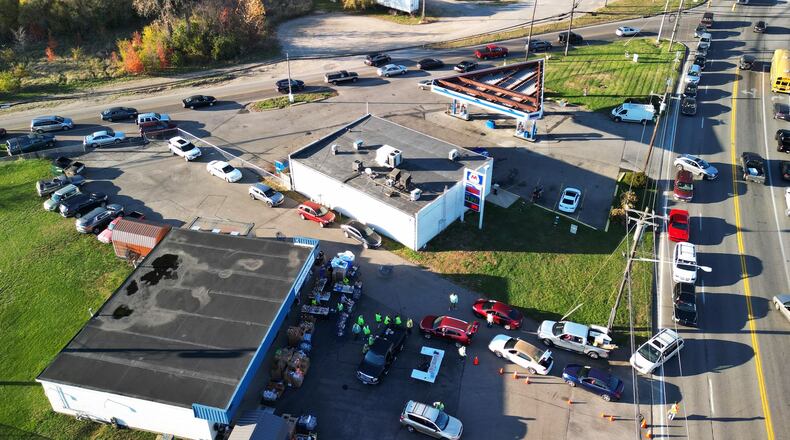>> DONATE TO JOURNAL-NEWS FOOD RELIEF
Benson is the founder and director of New Miami’s Village Food Pantry. Today, she came straight from work at the Ford transmission plant in Sharonville.
Three hours later, Benson is limping down Riverside Drive in Crocs. She walks more than the length of a football field to Dollar General, where the line of cars has stopped for a moment. The food pantry is closing. To be more specific, it’s in the process of closing.
Benson and her volunteers won’t leave for another hour and a half.
In this small village, where the median household income is $29,193 less than the rest of Butler County, the drive-thru pantry gridlocks traffic every Wednesday. Some people wait 2 hours to get food Benson and her volunteers pass out.
As Benson walks along the fence that night, some people roll down their window and ask if there is anything left. She tells them there is. When she reaches the last car, she limps into the road and places a parking cone on its trunk.
This will be the last one tonight.
‘We give them what we can’
Credit: Nick Graham
Credit: Nick Graham
Several hours earlier, Benson hugs the volunteer who shows up to direct traffic. Benson is wearing a yellow vest and winter hat with fur on the inside. Cones block the food pantry’s entrance. It is 3:40 p.m., and Benson is waving her hands around in the middle of the street.
“You got to keep going,” she yells. “Keep going.”
Cars are not permitted to line up until 3:50 p.m. Benson walks inside. It is almost time.
“Are you ready, ladies?” Benson shouts. “Let them in.”
Out front, there are shopping carts filled with bags. One has Brussel sprouts, salad and eggplant. Another has orange juice, milk and chocolate milk. On a folding table, there are boxes and boxes filled with manilla folders, sorted in alphabetical order.
Outside, Benson takes IDs from drivers and hands them to volunteers at the table. They look for a name to match the ID and fill out paperwork. Benson rifles through folders. It’s something like 40 degrees and getting colder.
She is not wearing gloves.
“How’s your foot, sweetheart?” one man asks Benson before handing her an ID.
Some people come here every week. Some are here for the first time. Some ask for information about other pantries.
“We can’t give them enough to sustain them for a week,” says Steve Reed, executive assistant at the pantry. “We give them what we can.”
On this day, they serve 395 families.
‘The Happy Place’
Benson was born and raised in New Miami.
Standing outside the pantry, she points in the direction of her childhood home. It’s less than half a mile up the road on Fox Avenue. That’s why the food pantry is located here in a building that used to be a beauty salon and a tax office.
Benson is looking for other locations but hasn’t found anything in the village. Inside, a sign above the makeshift kitchen says, “The Happy Place.” It is not the only sign in the building that says that.
This pantry runs on donations, but Benson and her mom signed the lease.
To hear her tell it, Benson’s sister loved couponing. The kind of couponing you might see on TV. One day, they were spending time together when their cousin left to pick up food from Panera Bread. Food Panera didn’t want.
The next day, Benson drove to the same location and began picking up food that would have otherwise been thrown away. She and her sister used coupons to buy extra items. Soon, they were feeding two people a week.
“We were tickled to death,” she says.
Eventually, they moved this operation into her church. And during the pandemic, they served 75 people a week. Now, she orders trucks of food from Shared Harvest, one of the pantry’s partners.
Benson sometimes orders eight tons of food.
Credit: Nick Graham
Credit: Nick Graham
The pantry outgrew the church. Some would say it’s outgrown its location now. Benson says the sheriff’s office gets calls every week about traffic.
On a recent Wednesday evening on Hamilton Eaton Road, the stoplight changes. First, it flashes yellow. Then red. No one moves. The light changes to green, and still, no one moves.
At a gas station on the corner, a pantry volunteer holds traffic so it doesn’t block the business’ entrance. At one point, people begin driving through a gravel parking lot on the side of the road to get past. The stoplight cycles from green to red 11 times before one car gets through the intersection.
It continues this way for most of the night.
A couple hours after opening, a man walks up to the pantry with his ID in hand. He says his car overheated and he pulled into Dollar General.
He asks if he can still pick anything up.
How to help
Village Pantry and many other Ohio food pantries order their stock from Shared Harvest, a Fairfield-based food bank that essentially distributes bulk and wholesale items to smaller food pantries. A worldwide food shortage has made that job considerably difficult for Shared Harvest officials.
To give money to support Shared Harvest, find a donation envelope in today’s print newspaper or go online to journal-news.com/foodrelief.
About the Author



